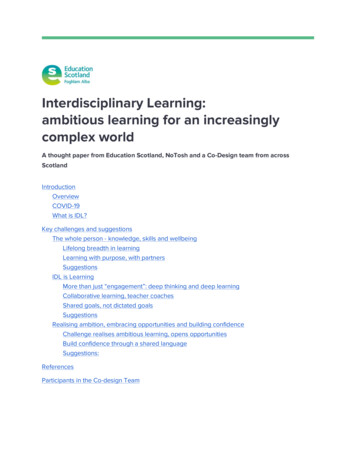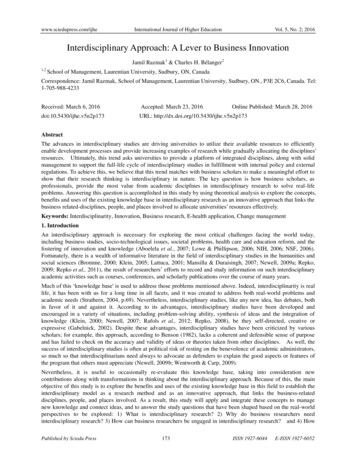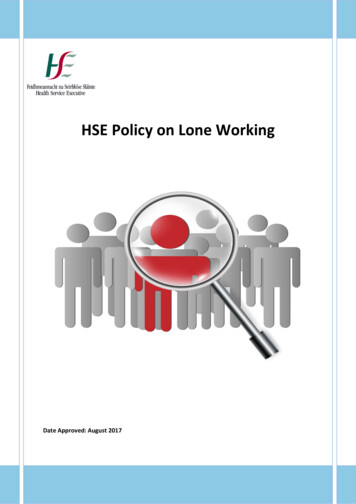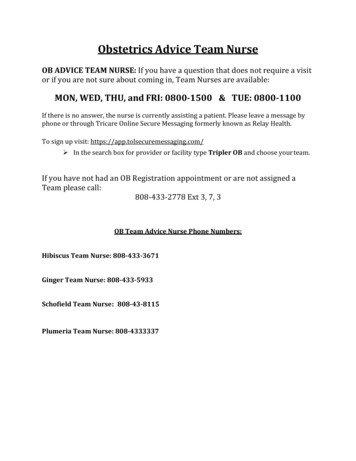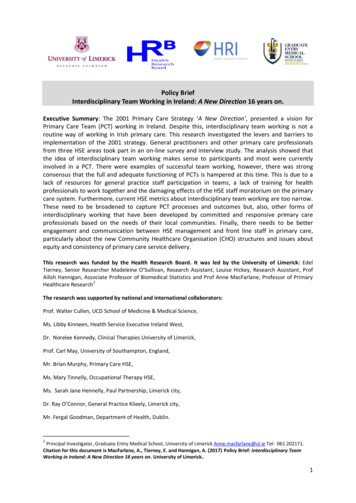
Transcription
Policy BriefInterdisciplinary Team Working in Ireland: A New Direction 16 years on.Executive Summary: The 2001 Primary Care Strategy ‘A New Direction’, presented a vision forPrimary Care Team (PCT) working in Ireland. Despite this, interdisciplinary team working is not aroutine way of working in Irish primary care. This research investigated the levers and barriers toimplementation of the 2001 strategy. General practitioners and other primary care professionalsfrom three HSE areas took part in an on-line survey and interview study. The analysis showed thatthe idea of interdisciplinary team working makes sense to participants and most were currentlyinvolved in a PCT. There were examples of successful team working, however, there was strongconsensus that the full and adequate functioning of PCTs is hampered at this time. This is due to alack of resources for general practice staff participation in teams, a lack of training for healthprofessionals to work together and the damaging effects of the HSE staff moratorium on the primarycare system. Furthermore, current HSE metrics about interdisciplinary team working are too narrow.These need to be broadened to capture PCT processes and outcomes but, also, other forms ofinterdisciplinary working that have been developed by committed and responsive primary careprofessionals based on the needs of their local communities. Finally, there needs to be betterengagement and communication between HSE management and front line staff in primary care,particularly about the new Community Healthcare Organisation (CHO) structures and issues aboutequity and consistency of primary care service delivery.This research was funded by the Health Research Board. It was led by the University of Limerick: EdelTierney, Senior Researcher Madeleine O’Sullivan, Research Assistant, Louise Hickey, Research Assistant, ProfAilish Hannigan, Associate Professor of Biomedical Statistics and Prof Anne MacFarlane, Professor of Primary1Healthcare ResearchThe research was supported by national and international collaborators:Prof. Walter Cullen, UCD School of Medicine & Medical Science,Ms. Libby Kinneen, Health Service Executive Ireland West,Dr. Norelee Kennedy, Clinical Therapies University of Limerick,Prof. Carl May, University of Southampton, England,Mr. Brian Murphy, Primary Care HSE,Ms. Mary Tinnelly, Occupational Therapy HSE,Ms. Sarah Jane Hennelly, Paul Partnership, Limerick city,Dr. Ray O’Connor, General Practice Kileely, Limerick city,Mr. Fergal Goodman, Department of Health, Dublin.1Principal Investigator, Graduate Entry Medical School, University of Limerick Anne.macfarlane@ul.ie Tel: 061 202171.Citation for this document is MacFarlane, A., Tierney, E. and Hannigan, A. (2017) Policy Brief: Interdisciplinary TeamWorking in Ireland: A New Direction 16 years on. University of Limerick.1
BackgroundInternationally, primary care is the cornerstone of healthcare planning and reform and there is anemphasis on interdisciplinary team working (WHO, 2008). Despite these policy imperatives, it hasbeen challenging to implement interdisciplinary team working as a routine way of working in anumber of developed countries, including Ireland (Phillips and Bazemore, 2010; O’Sullivan, Cullenand MacFarlane, 2014). However, there is a lack of research about levers and barriers toimplementation. The aim of this research was to analyse levers and barriers to implementation ofinterdisciplinary team working in Ireland by examining:1.2.Interdisciplinary team working promoted by the 2001 Primary Care strategy, that is HSEPrimary Care Teams (PCTs),Other forms of interdisciplinary working, initiated by primary healthcare professionals torespond to local needs, that is ‘bottom up’ innovation.This research offers a comprehensive exploration of what kind of interdisciplinary practices areworking well in primary care settings in Ireland at this time and why.MethodsThe research was conducted in HSE West, HSE South and HSE Dublin-Mid Leinster between 2014 and2017 (see Appendix I). It involved: An online survey with GPs and HSE Primary Health Care (PHC) professionals which received 569responses (71 GPs, 498 HSE staff),An interview study with forty one qualitative in-depth interviews with GPs and Primary HealthCare (PHC) professionals and HSE management.Principal findings about levers and barriers to implementation of interdisciplinary team working inIreland The majority of participants in the survey and interview study understand and support the policyimperative for interdisciplinary working in primary care to enhance patient care. Interdisciplinaryworking makes sense to them (lever),The majority of participants in the survey and interview study were taking part in HSE PCTclinical meetings in their area (lever),The majority of participants in the survey and interview study considered that there is a lack ofprogress with the implementation of PCTs in the HSE in general. There is considerable frustrationabout this (barrier),Participants provided some positive examples from their own specific experience of PCTs,including respectful interdisciplinary team working and successful management of patientreferrals for those in urgent and complex situations (lever),There was a notable absence of discussion about community participation in PCTs (barrier),There was a strong view across the survey and interview study that more resources are neededto realise the full potential of PCTs (barrier):o GP attendance is considered pivotal for effective team meetings and is disrupted bylack of payments for GPs to attend PCT meetingso There are no resources for practice nurse participation in PCT meetingso The lack of resources in the primary care system means that PCT meetings focus onurgent referrals rather than on the broader aspects of primary healthcare i.e. healthpromotion and disease prevention2
oo HSE PCT clinical meetings are administratively resource intensive. This is challengingfor service providers who are dealing with increasingly complex patient needs in asystem with diminished resources since the recessionStaff need training to work effectively together across disciplines.There was frustration among the majority of participants in the interview study that HSE metricsfor PCT working are limited to quantitative information about the meetings e.g. how manymeetings took place, who was in attendance and how many patients were discussed (barrier),There are many examples in the survey and interview study of other forms of interdisciplinaryworking that were initiated locally (see Appendix II). These include services for health promotion(e.g. mother and toddler groups, programmes to support healthy eating on a limited budget)and chronic disease management (e.g. care for people with chronic obstructive pulmonarydisease). This kind of ‘bottom up’ interdisciplinary team working is not captured in the currentHSE metrics about interdisciplinary working and participants regard this as a problem. This isimportant work in primary care and needs to be acknowledged and resourced (barrier),Interview study participants explained that the recession has decimated resources in primarycare in general and put increasing pressure on front line staff. Some ‘bottom up’ interdisciplinaryservices that were initiated at a local level have ceased to operate as staff are forced to ‘firefight’ waiting lists in their respective disciplines (barrier),There is a lack of clarity and consistency among front line staff about health system issuesincluding the nature of on-going reforms (e.g. CHO area developments) and equity of serviceprovision (e.g. uncertainty about whether public patient status or clinical need should be used toprioritise waiting lists) (barrier).ConclusionInterdisciplinary team working is integral to the delivery of comprehensive primary care in Ireland.This is acknowledged and understood by clinicians and management personnel working in primarycare settings. While this represents important levers for implementation, there was a strongconsensus among these stakeholders that interdisciplinary team working in primary care in Irelandwill only realise its potential if there are more resources allocated to team functioning as well as theprimary care system more broadly. A modified set of HSE metrics is also needed to capture the fullbreadth of interdisciplinary team working that is taking place and better communication is requiredbetween HSE management and frontline staff (GPs and other primary health care professionals)about healthcare system development options and decisions. These findings are supported bynational and international research about interdisciplinary working in primary care (O’Sullivan,Cullen and MacFarlane, 2014; Kelly, Garvey and Palcic, 2016; O’Reilly et al., in press).Recommendations1. Increase the available resources for primary care Revise GP contracts to provide resources to support GP and practice nurse involvement inHSE PCTs,Increase the resources for PCT staffing to:o Increase the current level of administrative supporto Back fill posts for maternity leave sick, leave etc.o Develop new posts to meet the ever increasing complexity of patient and serviceuser needs,Provide resources for training for general practice staff and primary health careprofessionals to work together in HSE PCTs,2Increase resources for PCT infrastructure so that physical space/ rooms are available forprevention and intervention work in primary care.2The national curriculum on inter-professional education which will be launched in September for new graduates isrelevant here3
2. Modify HSE metrics about interdisciplinary team working Provide administrative resources to support PCTs and to gather information for current HSEmetrics about PCTs, Develop new metrics about the:o Quality of team workingo Outcomes of team workingo Nature of community participation being conducted in PCTso Other forms of interdisciplinary work that are taking place by asking front lineproviders “is there any other work you are doing which should be acknowledged as awhole system approach to interdisciplinary team working?”. The HSE excellenceawards criteria could be used to gather these data.3. Improve engagement and communication between stakeholders in management and ‘onthe ground’ HSE management should improve engagement and communication with GPs and otherprimary health care professionals ‘on the ground’ about healthcare system developmentoptions and decisions e.g. about the new CHO Structures and the impact on equity andconsistency of service.ReferencesKelly N, Garvey J, Palcic D. Health policy and the policymaking system: A case study of primary carein Ireland. Health Policy 2016:120;913-919.O’Reilly P, Lee SH, O’Sullivan M, Cullen, W, Kennedy C, MacFarlane A. Assessing the facilitators andbarriers of interdisciplinary team working in primary care using normalisation process theory: Anintegrative review. Plos One (in press).O’Sullivan M, W Culllen, MacFarlane A. Primary Care Teams in Ireland: A qualitative mapping reviewof Irish grey and published literature. Irish Journal of Medical Science 2014. doi:DOI 10.1007/s11845014-1128-x.Phillips RL, Bazemore AW. Primary Care And Why It Matters For U.S. Health System Reform. HealthAffairs. 2010;29(5):806-10. doi:10.1377/hlthaff.2010.0020.World Health Organisation. Primary health care: now more than ever. Geneva: World HealthOrganisation; 2008.4
APPENDIX 1Description of the study sampleSurvey sample3There were 569 eligible responses including 71 GPs (response rate of 71 %) and 498 other healthcareprofessionals (response rate at most 22 % of HSE full-time equivalent posts). Respondents from theHSE in the main comprised OTs, Physiotherapists and SLTs (hereafter grouped together and calledclinical therapists). While most occupations within the HSE were adequately represented in thesample, nurses were under represented. Of the 71 GPs who responded, 34 % were in rural practices,41 % were in mixed urban/rural practices and 24 % were in urban practices, largely representative ofall GP practices in Ireland. Response rates across the three regions were broadly similar.Of those who provided valid demographic information (n 427), respondents were predominantlyfemale (82 %) and the majority (72 %) were aged less than 50 years. The majority of respondents (53%) were 15 years or more post qualification. Of the 71 GPs, the majority (62 %) were male; aged 50years or more (57 %) and were 15 years or more post qualification (67 %), representative of the GPprofile in Ireland(23). 78 % of respondents reported that they were a member of a formal PCT.3from Tierney E, O’Sullivan M, Hickey L., et al., ‘Do primary care professions agree about progress with implementation ofPrimary Care Teams: Results from a cross sectional study’, BMC Family Practice, 2016, 17(163), 1–235
Demographics of respondents to survey (n 569)3Characteristicn% of totalresponses% of validresponses 3510618.625.136-4919734.646.7 5011920.928.2Not given14725.8Female34460.581.5Male7813.718.5Not .02.88.41-55-1010-1515 Not givenHSE .6HSE WestHSE Dublin Mid-LeinsterHSE SouthNot givenMember of a formal primary care 268.219.212.678.121.9Age groupGenderOccupationOccupational therapistGeneral practitionerPhysiotherapistPublic health/registered generalnurseSpeech and language therapistManagerDieticianSocial WorkerPsychologist /CounsellorOther occupations2No occupation givenYears since qualificationYesNoNot applicable/not given % of responses excluding not given home help, community pharmacist, community worker, dentist, primary carefacilitator, community doctor, general practice administration staff, general practice nurse, community welfare officer,area medical officer6
Interview study sampleLocationCS Site 1Private GP- Ledinterdisciplinary teamwith self-employed clinicalstaffCS Site 2HSE PCTCS Site 3HSE PCTNN 102 GPs2 Physiotherapist1 Practice Manager1 Office Manager1 Dietician1 Podiatrist1 Primary CareDevelopment Officer1 Operations ManagerN 82 Public Health Nurses1 Centre Manager1 Social Worker1 Physiotherapist1 Clerical Officer1 GP1 Occupational TherapistN 195 GPs3 Physiotherapist3 Public Health Nurses1 Assistant Director PublicHealth Nurse2 Psychologist1 Occupational TherapistManager1 Occupational Therapist1 Speech and LanguageTherapist1 Home Help Coordinator1 Primary CareDevelopment OfficerDemographicsMale 2 and Female 8Age range 27-55 yearsMale 2 and Female 6Age range 29-65 yearsMale 5 Female 14Age range 28-52 yearsForty-one interviews were conducted with 39 individuals. The majority were female. Theparticipants represented a cross section of health care professionals working on PCTs and a privateGP led team. The age range was 27-65 and there was representation of a range of experience ofworking in primary care settings in Ireland.7
APPENDIX IIExamples of ‘bottom-up’ interdisciplinary innovations in Irish primary carereported in the survey and interview studyDesign and delivery of educational events in the community for preventive care and healthpromotion:Social worker, Dietician and Public Health Nurses working together on a Healthy Eating on a Budgetprogramme for patients of their PCT, which was located in a deprived area,Public Health Nurses, Occupational Therapists and Physiotherapists working together on a FallsPrevention Programme for older people,Psychologist, Psychiatrist, GP, community youth worker, local business people and Garda LiaisonOfficer working together to deliver a Youth Mental Health programme to provide counsellingsupport and foster positive mental health initiatives for young people.Development of integrated care plans for people with complex health needs:GPs, Public Health Nurses, Assistant Director of Public Health Nursing, Occupational TherapyManager, Occupational Therapist and Physiotherapist working together to create new communitybased services for people with dementia,Nurses, Dietitians, Physiotherapists, Occupational therapists, Speech and language therapistsworking together to plan care for patients after hospital discharge,Joint Public Health Nurse, Physiotherapist and Occupational therapist visits to clients in their homesto support them and their carers, for example joint visits to people living with MS.Advocacy on behalf of patients:GP and Public Health Nurse liaising with each other, and with social services, for example Meals onWheels services, to support older people to live in their homes.8
Interdisciplinary team working is integral to the delivery of comprehensive primary care in Ireland. This is acknowledged and understood by clinicians and management personnel working in primary care settings. While this represents important levers for implementation, there was a strong consensus among these stakeholders that interdisciplinary .
